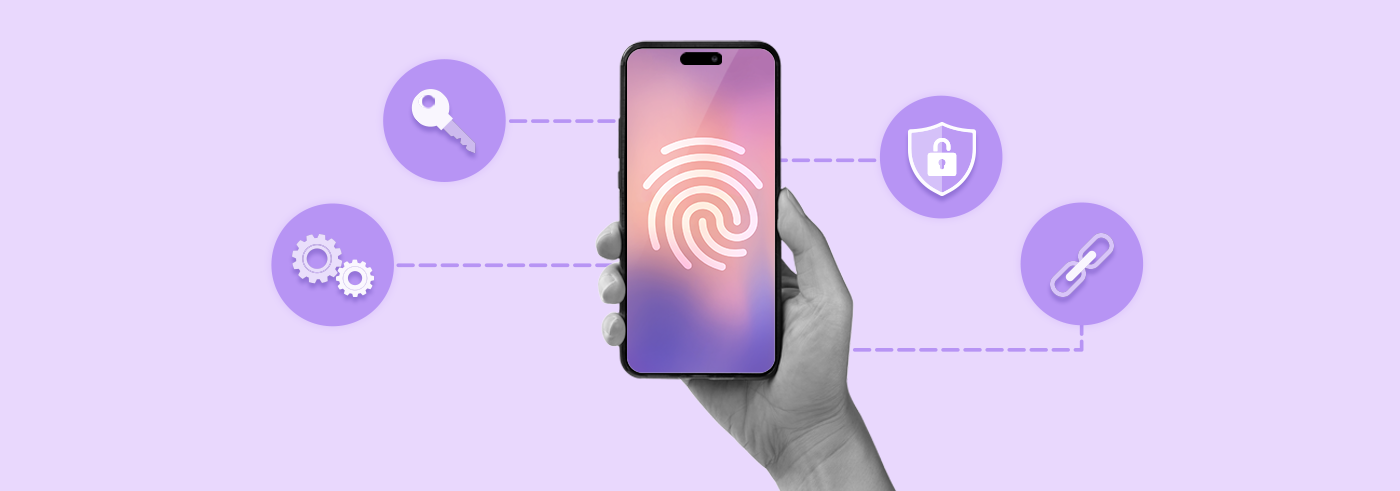Email is a vast platform due to its broad range of communication and widespread use. It is also the most common medium for cyberattacks, as it was developed to be accessible to anyone because of its immense benefit. However, during the early days of email, these hacks went mostly unprevented due to the inefficiency of technology.
Table of Contents
- What is Email Security?
- Why Should You Use Email Security Software?
- Common Email Security Measures
- Types of Email Security Features
- Best Practices to Adopt for Email Security
- Most Common Email Security Trends
Emails were an easy target for cybercriminals to extract data from people without their knowledge, as they can be altered at the time of transfer or when they are sent. The hackers use various methods to take control of the emails and review the content inside.
These attackers also use emails as a fraudulent means to attract people to open the click-through links and infect the receiver's device with malware and ransomware viruses, making email security an essential aspect to be added to company policies.
This article will assist you in learning more about email security and its importance. We will also go through the best email security practices to deeply understand what they stand for. We will also give you more information regarding email protection. So let's get started!
What is Email Security?
As you're likely aware, email has become an essential means of communication in our personal and professional lives. It is used for exchanging important information, sensitive data, and confidential messages. However, the convenience of email also poses a threat to our security and privacy. This is where email security comes into play.
Email security refers to the measures taken to protect email accounts, messages and attachments from unauthorized access, interception or theft.
Why Should You Use Email Security Software?
As you know, keeping your emails and private messages secure has become very difficult with the rapid increase in cybercrime. If you still believe in the built-in security features included with your gadgets, it's high time to switch to other methods for better security.
You should know that keeping your emails secure is important for the growth of your organization while protecting what is confidential and transmitted via email. You can look at the best email security practices mentioned in the article to learn more.
- You must know that 90% of cyberattacks cause email breaches and destroy valuable information. You can protect your emails from viruses like ransomware, malware, anonymous deception, phishing or hacking.
- If these random hackings leak your organization’s data, you might lose stability. Moreover, the respect and trust of potential prospects could fade as email hacks can lead to major mishaps, including employee turnoffs.
If you have email security within your systems, it can save you the time and trouble you must go through if you see something unusual happening with your emails, resulting in significant hacking.
Common Email Security Measures
Check Point's Survey says 81% of malicious data is spread through emails, which is huge. So, to avoid such practices, let us go through some of the common measures of email security that should be followed.
- One of the most common email security measures is encryption. Encryption is the process of encoding the contents of an email so that only the intended recipient can decipher it. It means that even if a hacker intercepts the email, they will not be able to read its contents.
- Another important aspect of email security is authentication. Authentication helps ensure that the sender of an email is who they claim to be. It is done through the use of digital signatures, which are unique identifiers that are attached to an email.
- Email security also protects against email-based threats, such as phishing, malware and spam. To protect against these threats, email security measures, including spam filters, DMARC software antivirus software and user education, are generally taken.
Still, companies should develop cybersecurity training strategies and add email protection software to their policies and company budgets to keep their data and client data secure from external threats while using sustainable business practices to ensure long-term security and efficiency. It's also imperative to have a robust cyber incident response plan in the unfortunate event of an email marketing scam.
Types of Email Security Features
Email security threats have become a rising concern, compelling organizations to have a focused strategy to eliminate threats like phishing emails and fraudulent emails marked as sent by trusted senders. Attackers can bluff them easily because of their creative and varied format.
In order to learn more, it enables the recipients to share information and personal data, but in either case, they risk having their data stolen by an unintentional cybercriminal. Email security services have a strategy to outrun various protection threats for emails.
Some types of email security features are mentioned below to help you better understand why you should have them in your organizations.
1. Separating Spam Email
Many businesses use email marketing tactics to send a large number of marketing emails, which can inundate recipients' email inboxes. Finding important emails can occasionally be challenging because of the sheer volume of emails, and some might even get lost.
You can lose sight of your business-related and necessary emails in the pile of marketing emails. The cyber attackers use these marketing emails as a cut-through to your email accounts and add their malicious links within the email.
An inexperienced user may fail to scrutinize the authenticity of an email, thereby leaving them vulnerable to fraudulent attacks that aim to trick them into divulging sensitive information such as their banking and credit card details. As such, using a spam filter can be an effective way to fulfill your needs and sidestep unnecessary emails.
You can install the spam filter to help you separate these advertising emails from the actual emails that concern you. These spam emails can also be deleted automatically by fixing their deletion time after a certain number of days.
2. Email Anti-virus Protection
Spam filters block malicious emails from being opened by the viewer by separating them from the actual emails of concern for the receiver. Still, it has no control over the user's accidental opening of these emails.
These spam emails stay in the system for some time, after which they are deleted automatically. What if the user goes through any of them? It might lead to the infiltration of malicious viruses into your system and undeniable access to all your information systems.
An email antivirus software can help you better fight against such hideous viruses as the pre-designed software keeps track of each incoming and outgoing email and restricts those with malicious data, providing a seamless data security mechanism.
3. Encrypting Data
You can use the spam email filter option and antivirus software to protect yourself from infected emails. Still, you cannot protect them in transit, as the transmitted emails are always sent in open format.
These open-format emails are the main targets of many cyber attackers. They use emails to infect them with malware and extract confidential client or receiver data when transmitted. That is why the sender should encrypt the information.
You can use the data encryption mechanism to protect the information when being transmitted from the sender to the receiver. It ensures that each outgoing email is data encrypted and safeguarded from attackers.
Encrypting email means you have protected it by closing all access to the email's content. It is important for organizations to initiate this security feature in their emailing systems to protect client data and individuals in particular.
Best Practices to Adopt for Email Security
1. Use Strong and Unique Passwords
Using strong and unique passwords is an essential best practice for email security. Weak passwords can be easily guessed or cracked by hackers, putting your account at risk of being compromised. To avoid this, create a mix of uppercase and lowercase letters, numbers, and symbols to create a strong and unique password. Avoid using common passwords such as "password" or "123456," as these are easy for hackers to guess.
Additionally, consider using an open source password manager to generate and store complex passwords securely. Password managers are tools that generate strong, unique passwords for you and store them securely. They can also help you to remember your passwords, so you don't have to write them down or remember them all. With a password manager, you only need to remember one master password, which makes it easier to use strong and unique passwords for all your online accounts.
2. Access the Email Protection Software
You can access high-security tools that protect your emails from phishing and spear-phishing threats, and complement them with learnings from a cyber security course to better understand evolving threats. Invest in a credential manager and anti-bluff email protection software to prevent the spread of fraudulent emails. You can also use software to check an email for authenticity. It will verify if the email is from an authentic source, not spam.
Here are options you can use:
- Mimecast is used to protect emails against phishing.
- NordPass allows the user to create trusted credentials with an unlimited capacity for storing passwords.
You can also access the email firewall mechanism to restrict malware and other issue-facing emails during the scanning process to prevent them from reaching their domain.
3. Activate Dual Authentication
When you use two-factor authentication to protect your email, attackers will find it much harder to access the account's content. They will need to figure out how to combine two different pieces of information the email account holder has provided.
To activate the 2FA security protocol, you can access your account settings and modify your credential management accordingly. It's important to note that most websites and security services do not have this setting enabled by default. You will need to manually activate it.
4. Do Not Connect to Non-Trusted Wi-Fi
With the use of open or public Wi-Fi networks, it can be easy for hackers to gain insight into your system's information database and access your stored information. It would help to always use password-protected Wi-Fi in the office or WPA enabled for remote work.
You can also use VPN servers to protect your data, as these VPN networks hide your location and transmit the server elsewhere across the globe. However, this uses open Wi-Fi, which can make you more volatile and provide undeniable access to your system.
The Wi-Fi networks that you regularly use are far more secure than an open Wi-Fi network that is accessible to a large number of people simultaneously. It's worth noting that a trusted network typically has an administrator who oversees security protocols and can take steps to prevent the unauthorized disclosure of private data over Wi-Fi.
5. Check DMARC
You can authorize your DMARC protection platform, which protects the organization from cyber criminals. You can easily look into email phishing in your emails and avoid attackers that create genuine-looking corporate domain names in the hacking process.
There are two strategies to initiate DMARC authentication:
- The Sender Policy Framework (SPF) chooses and blocks the network from which an email is sent. It uses a fraudulent domain name and gives you complete control over email spoofing.
- Domain Keys Identified Mail (DKIM) lowers the probability of your emails being marked as spam and alerts the attackers not to try to mislead your email integrated with SPF.
You can analyze your email through DMARC to see if attackers are mistreating your company by using your domain names and spoofing your campaigns. Integrating SPF, DKIM, and DMARC provider can provide high security against all.
Most Common Email Security Trends
The latest email trends are something you must know about in this era of security theft. These trends will give you an idea of why keeping your emails safe and protecting them from cyber-attacks is important.
1. Multi-Factor Authorization Spoof
Multi-Factor Authentication (MFA) is a security feature that requires users to provide more than one method of authentication to access their email accounts. This additional layer of security helps to prevent unauthorized access to sensitive information and reduces the risk of cyberattacks such as phishing, social engineering, and brute force attacks.
However, cybercriminals are becoming increasingly sophisticated in their attacks and can even spoof the MFA system to gain access to email accounts. In these cases, the hackers intercept the authentication code and use it to log into the victim's account. In some cases, a lack of effective anti spyware apps on a device allows hackers to install keyloggers or intercept tools that compromise even MFA-protected email accounts.
To prevent MFA spoofing, users should be vigilant when providing their authentication details and avoid sharing sensitive information via email or other unsecured channels.
To strengthen MFA systems further, organizations should integrate privileged access management solutions. These tools provide additional oversight by ensuring that sensitive accounts with elevated access rights are closely monitored and secured.
2. Email Impersonation Spoofing
Email impersonation spoofing is a common technique used by cybercriminals to trick users into revealing sensitive information or taking harmful actions. In this technique, attackers use various methods such as phishing, spear-phishing or whaling attacks to impersonate a legitimate entity or person and send fraudulent emails to the target.
To prevent email impersonation spoofing, organizations and individuals can take several measures. They can start by implementing email authentication protocols such as SPF, DKIM, and DMARC. They are a critical step in preventing unauthorized parties from sending emails on behalf of the organization or individual. These protocols work by verifying the sender's identity and checking if the email comes from a legitimate source. Additionally, you can also verify individual email addresses through an email verification tool as a secondary step. Most email finder tools that are generally used to find email addresses come with an email verification feature that verifies email to check if it’s authentic or not.
3. ICES Over SEGs
The future of email security solutions is Integrated Cloud Emailing Security, which differs from SEGs. Secure Email Gateways (SEGs) can be effective in protecting email communication, but they can also pose a threat if they are not configured correctly or if they are misused. Unlike Secure Email Gateways, ICES uses API systems to build an email connection rather than DNS records.
ICES prefers natural language programming (NLP) and representable AI services to assist with email protection and destroy unwanted emails that are useless to the organization. You cannot trust SEGs for high-end email verification.







